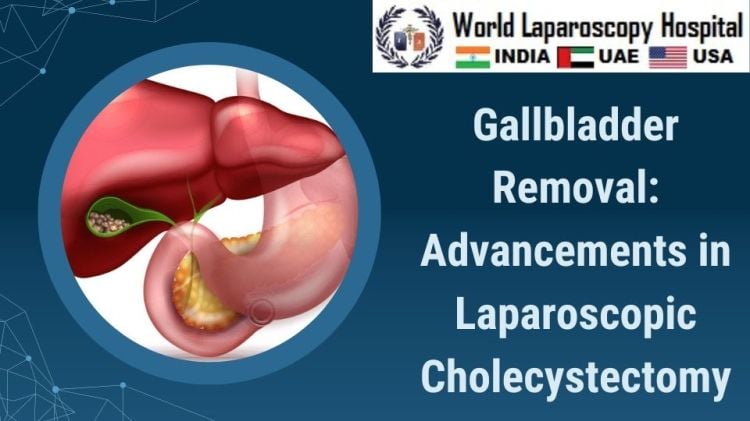Introduction:
Gallbladder removal, or cholecystectomy, has undergone a transformative journey with the advent of laparoscopic surgery. This minimally invasive approach has revolutionized the way surgeons address gallbladder-related issues, offering patients numerous benefits compared to traditional open surgery. In this comprehensive exploration, we delve into the advancements in laparoscopic cholecystectomy, examining its history, techniques, benefits, and the future of gallbladder removal.

Historical Context:
To appreciate the advancements in laparoscopic cholecystectomy, it's crucial to understand the historical context of gallbladder surgery. Traditional open cholecystectomy, involving a large abdominal incision, was the standard procedure for decades. While effective, this approach often led to prolonged hospital stays, increased pain, and extended recovery periods.
The turning point came in the late 1980s when laparoscopic cholecystectomy emerged as a groundbreaking alternative. This technique involves making several small incisions, through which a tiny camera and specialized instruments are inserted to visualize and remove the gallbladder. Dr. Erich Mühe, a German surgeon, performed the first laparoscopic cholecystectomy in 1985, marking a paradigm shift in gallbladder surgery.
Laparoscopic Cholecystectomy Technique:
Trocar Placement and Insufflation:
Laparoscopic cholecystectomy begins with trocar placement. Trocars are pencil-thin instruments that serve as entry points for the camera and other tools. Typically, four small incisions are made in strategic locations on the abdomen. Carbon dioxide gas is then introduced to create a pneumoperitoneum, lifting the abdominal wall and providing a workspace for the surgeon.
Visualization:
A laparoscope, a long, slender tube equipped with a light source and camera, is inserted through one of the trocars. This provides high-resolution images of the abdominal cavity on a monitor, allowing the surgeon to navigate and identify key structures, including the gallbladder, with precision.
Dissection and Clipping:
Specialized instruments are introduced through the remaining trocars to dissect the gallbladder from surrounding tissues. The cystic duct and artery, which connect the gallbladder to the liver and blood vessels, are carefully identified and clipped or sealed to prevent bleeding. The gallbladder is then freed from its attachments.
Extraction:
Once detached, the gallbladder is extracted through one of the small incisions, often with the assistance of a retrieval bag. This marks the completion of the laparoscopic cholecystectomy procedure.
Advancements in Laparoscopic Cholecystectomy:
Single-Incision Laparoscopic Cholecystectomy (SILC):
Building on the principles of laparoscopy, SILC takes minimally invasive surgery a step further by utilizing a single incision, usually in the patient's navel. This technique aims to enhance cosmetic outcomes and reduce postoperative pain. While technically challenging, SILC has gained popularity as surgeons refine their skills and instrumentation improves.
Robotic-Assisted Cholecystectomy:
Robotic-assisted surgery introduces a robotic system, controlled by the surgeon, to perform precise movements with enhanced dexterity. This technology has found application in cholecystectomy, allowing for greater precision in dissection and suturing. Robotic-assisted cholecystectomy is an evolving field with ongoing research to optimize its benefits.
Fluorescence Imaging:
Incorporating fluorescence imaging into laparoscopic cholecystectomy enhances visualization of key structures. Fluorescent dyes are administered, selectively highlighting structures like the cystic duct and arteries under special lighting. This real-time imaging aids surgeons in identifying critical anatomy, reducing the risk of inadvertent injuries during the procedure.
Enhanced Recovery After Surgery (ERAS) Protocols:
Advancements in laparoscopic cholecystectomy extend beyond the operating room. ERAS protocols focus on optimizing preoperative, intraoperative, and postoperative care to accelerate recovery. This comprehensive approach includes preoperative counseling, early mobilization, and judicious pain management, contributing to shorter hospital stays and quicker return to normal activities.
Benefits of Laparoscopic Cholecystectomy:
Reduced Postoperative Pain:
Compared to open surgery, laparoscopic cholecystectomy is associated with significantly less postoperative pain. The smaller incisions and reduced tissue trauma contribute to a more comfortable recovery experience for patients.
Quicker Recovery and Shorter Hospital Stays:
The minimally invasive nature of laparoscopic cholecystectomy allows for a quicker recovery, enabling patients to return to their daily activities sooner. In many cases, patients can be discharged on the same day or within a short hospital stay, minimizing disruption to their lives.
Improved Cosmetic Outcomes:
The smaller incisions used in laparoscopic cholecystectomy result in minimal scarring, enhancing cosmetic outcomes. This is particularly relevant for patients who value the aesthetic aspect of surgery and wish to avoid prominent scars associated with open procedures.
Lower Complication Rates:
Laparoscopic cholecystectomy has demonstrated lower complication rates compared to open surgery. The reduced risk of infections, wound complications, and hernias contributes to the overall safety and success of the procedure.
Considerations and Challenges:
While laparoscopic cholecystectomy offers numerous advantages, certain considerations and challenges must be acknowledged. Patient selection, surgeon experience, and potential technical difficulties are factors that can influence outcomes. Additionally, rare complications such as bile duct injuries, though infrequent, highlight the importance of skilled surgeons and ongoing advancements in training and technology.
Future Directions and Innovations:
Artificial Intelligence in Surgical Planning:
The integration of artificial intelligence (AI) into laparoscopic cholecystectomy holds promise for enhancing surgical planning and decision-making. AI algorithms can analyze preoperative imaging, identify anatomical variations, and assist surgeons in tailoring their approach for optimal outcomes.
3D Printing for Surgical Simulation:
3D printing technology allows the creation of patient-specific anatomical models, enabling surgeons to simulate and plan procedures in advance. This innovation enhances training, particularly for complex cases, and contributes to improved surgical precision.
Telemedicine and Remote Surgical Assistance:
Advancements in telemedicine enable experienced surgeons to provide remote assistance and guidance during laparoscopic cholecystectomy procedures. This collaborative approach allows for real-time mentorship, enhancing the learning curve for less experienced surgeons and expanding access to specialized care.
Conclusion:
Laparoscopic cholecystectomy has evolved from a groundbreaking technique to the gold standard for gallbladder removal. Advancements in technology, techniques, and perioperative care have collectively transformed the landscape of gallbladder surgery, offering patients a safer, less invasive, and more efficient approach. As innovation continues, the future holds exciting possibilities for further refining laparoscopic cholecystectomy and expanding its application to other areas of surgery, ultimately benefiting patients and advancing the field of minimally invasive surgery.


